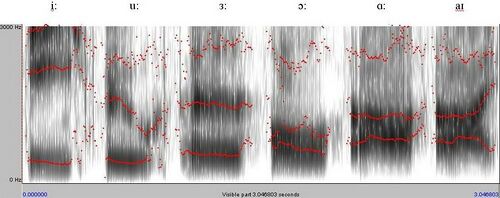Phonetics: Difference between revisions
imported>Aleksander Stos m (category cleanup) |
imported>Subpagination Bot m (Add {{subpages}} and remove any categories (details)) |
||
| Line 1: | Line 1: | ||
{{subpages}} | |||
{{linguistics}} | {{linguistics}} | ||
'''Phonetics'''<ref>From the [[Greek language|Greek]] word φωνή, ''phone'' = sound/voice.</ref> is the study of [[sound]]s and the [[human voice]]. It is concerned with the actual properties of speech sounds ([[phones]]) as well as those of non-speech sounds, and their production, audition and perception, as opposed to [[phonology]], which is the study of abstract units (such as [[phoneme]]s and [[distinctive feature]]s) which underlie both [[speech]] and [[writing]]. Phonetics deals with the sounds themselves rather than the contexts in which they are used in languages. Discussions of meaning ([[semantics]]) do not enter at this level of [[linguistics|linguistic analysis]], therefore. | '''Phonetics'''<ref>From the [[Greek language|Greek]] word φωνή, ''phone'' = sound/voice.</ref> is the study of [[sound]]s and the [[human voice]]. It is concerned with the actual properties of speech sounds ([[phones]]) as well as those of non-speech sounds, and their production, audition and perception, as opposed to [[phonology]], which is the study of abstract units (such as [[phoneme]]s and [[distinctive feature]]s) which underlie both [[speech]] and [[writing]]. Phonetics deals with the sounds themselves rather than the contexts in which they are used in languages. Discussions of meaning ([[semantics]]) do not enter at this level of [[linguistics|linguistic analysis]], therefore. | ||
| Line 42: | Line 44: | ||
*Rogers, Henry. (2000). ''The Sounds of Language: An Introduction to Phonetics''. Harlow, Essex: Pearson. ISBN 0-582-38182-7. | *Rogers, Henry. (2000). ''The Sounds of Language: An Introduction to Phonetics''. Harlow, Essex: Pearson. ISBN 0-582-38182-7. | ||
*Stevens, Kenneth N. (1998). ''Acoustic phonetics''. Current studies in linguistics (No. 30). Cambridge, MA: MIT Press. ISBN 0-2621-9404-X. | *Stevens, Kenneth N. (1998). ''Acoustic phonetics''. Current studies in linguistics (No. 30). Cambridge, MA: MIT Press. ISBN 0-2621-9404-X. | ||
Revision as of 14:24, 12 November 2007
Phonetics[1] is the study of sounds and the human voice. It is concerned with the actual properties of speech sounds (phones) as well as those of non-speech sounds, and their production, audition and perception, as opposed to phonology, which is the study of abstract units (such as phonemes and distinctive features) which underlie both speech and writing. Phonetics deals with the sounds themselves rather than the contexts in which they are used in languages. Discussions of meaning (semantics) do not enter at this level of linguistic analysis, therefore.
While writing systems and alphabets often attempt to represent the sounds of speech, phoneticians are more concerned with the sounds themselves than the symbols used to represent them. So close is the relationship between them, however, that many dictionaries list the study of the symbols (more accurately semiotics) as a part of phonetic studies. Logographic writing systems typically give much less phonetic information, although it is not necessarily non-existent. For instance, in Chinese characters, a phonetic is a portion of the character that hints at its pronunciation, while the radical gives semantic information. Characters featuring the same phonetic typically have similar pronunciations, but by no means are the pronunciations predictably determined by the phonetic; this is because pronunciations diverged over many centuries while the characters remained the same. Not all Chinese characters are radical-phonetic compounds, but a good majority of them are.
Phonetics has three main branches:
- articulatory phonetics, concerned with the positions and movements of the lips, tongue, vocal tract and folds and other speech organs in producing speech;
- acoustic phonetics, concerned with the properties of the sound waves and how they are received by the inner ear;
- auditory phonetics, concerned with speech perception, principally how the brain forms perceptual representations of the input it receives.
There are over a hundred different phones recognized as distinctive by the International Phonetic Association (IPA) and transcribed in their International Phonetic Alphabet.
Phonetics was studied as early as 2500 years ago in ancient India, with Pāṇini's account of the place and manner of articulation of consonants in his 5th century BCE treatise on Sanskrit. The major Indic alphabets today, except Tamil script, order their consonants according to Pāṇini's classification.

See also
External links and references
- Compure - Phonetic Index Search Technology
- The sounds and sound patterns of language U Penn
- UCLA lab data
- UCLA Phonetics Lab Archive
- EGG and Voice Quality (electroglottography, phonation, etc.)
- single sound per symbol phonetic writing system(simple phonetic symbols for English language)
- IPA handbook
- Speech Analysis Tutorial
- Lecture materials in German on phonetics & phonology, university of Erfurt
- Real-time MRI video of the articulation of speech sounds, from the USC Speech Articulation and kNowledge (SPAN) Group
Bibliography
- Catford, J. C. (1977). Fundamental problems in phonetics. Bloomington, IN: Indiana University Press. ISBN 0-253-32520-X.
- Clark, John; & Yallop, Colin. (1995). An introduction to phonetics and phonology (2nd ed.). Oxford: Blackwell. ISBN 0-631-19452-5.
- Hardcastle, William J.; & Laver, John (Eds.). (1997). The handbook of phonetic sciences. Oxford: Blackwell Publishers. ISBN 0-6311-8848-7.
- Ladefoged, Peter. (1982). A course in phonetics (2nd ed.). London: Harcourt Brace Jovanovich.
- Ladefoged, Peter. (2003). Phonetic data analysis: An introduction to fieldwork and instrumental techniques. Malden, MA: Blackwell Publishing. ISBN 0-631-23269-9 (hbk); ISBN 0-631-23270-2 (pbk).
- Ladefoged, Peter; & Maddieson, Ian. (1996). The sounds of the world's languages. Oxford: Blackwell Publishers. ISBN 0-631-19814-8 (hbk); ISBN 0-631-19815-6 (pbk).
- Maddieson, Ian. (1984). Patterns of sounds. Cambridge studies in speech science and communication. Cambridge: Cambridge University Press.
- Pike, Kenneth L. (1943). Phonetics: A critical analysis of phonetic theory and a technic for the practical description of sounds. Ann Arbor: University of Michigan Press.
- Pisoni, David B.; & Remez, Robert E. (Eds.). (2004). The handbook of speech perception. Oxford: Blackwell. ISBN 0-6312-2927-2.
- Rogers, Henry. (2000). The Sounds of Language: An Introduction to Phonetics. Harlow, Essex: Pearson. ISBN 0-582-38182-7.
- Stevens, Kenneth N. (1998). Acoustic phonetics. Current studies in linguistics (No. 30). Cambridge, MA: MIT Press. ISBN 0-2621-9404-X.